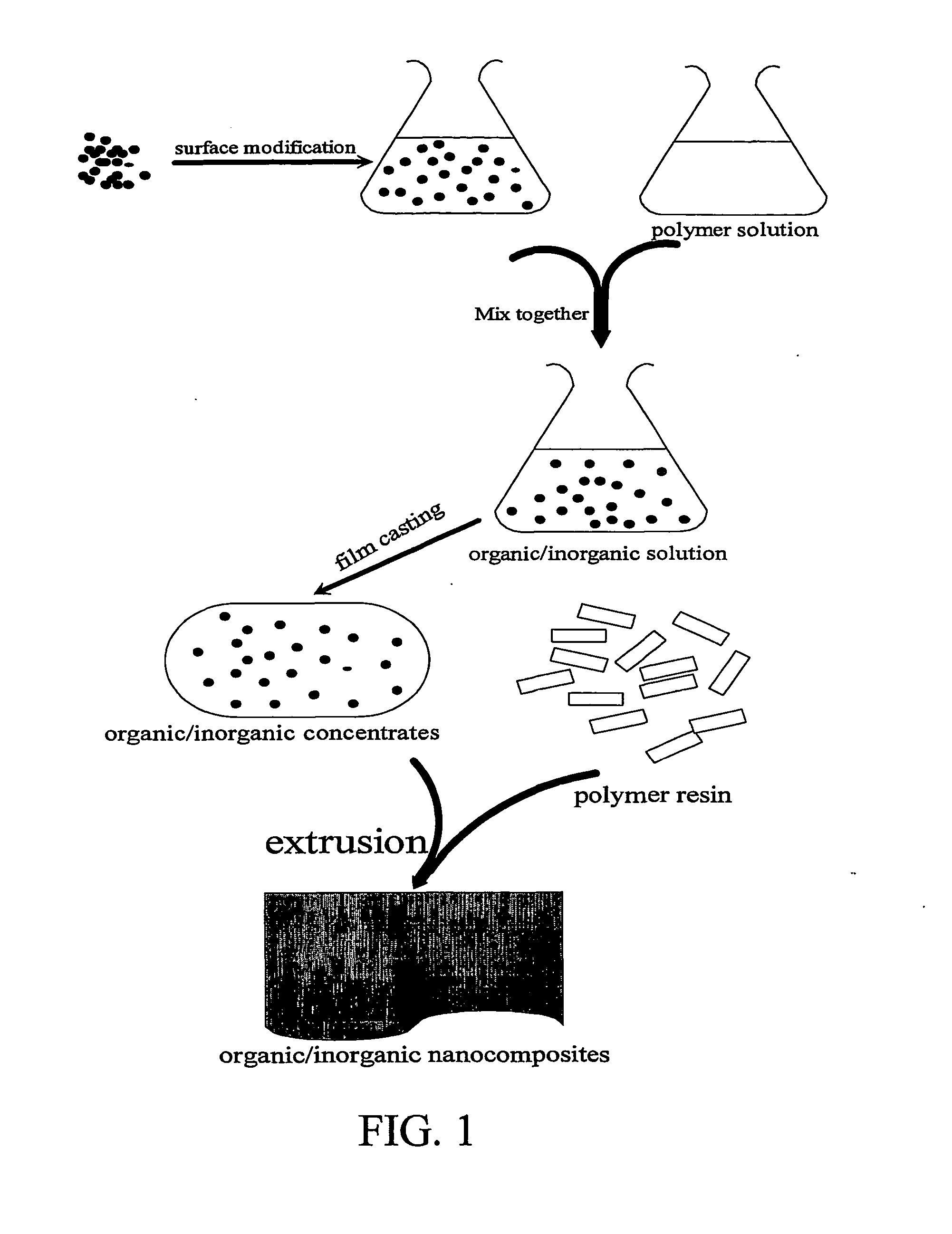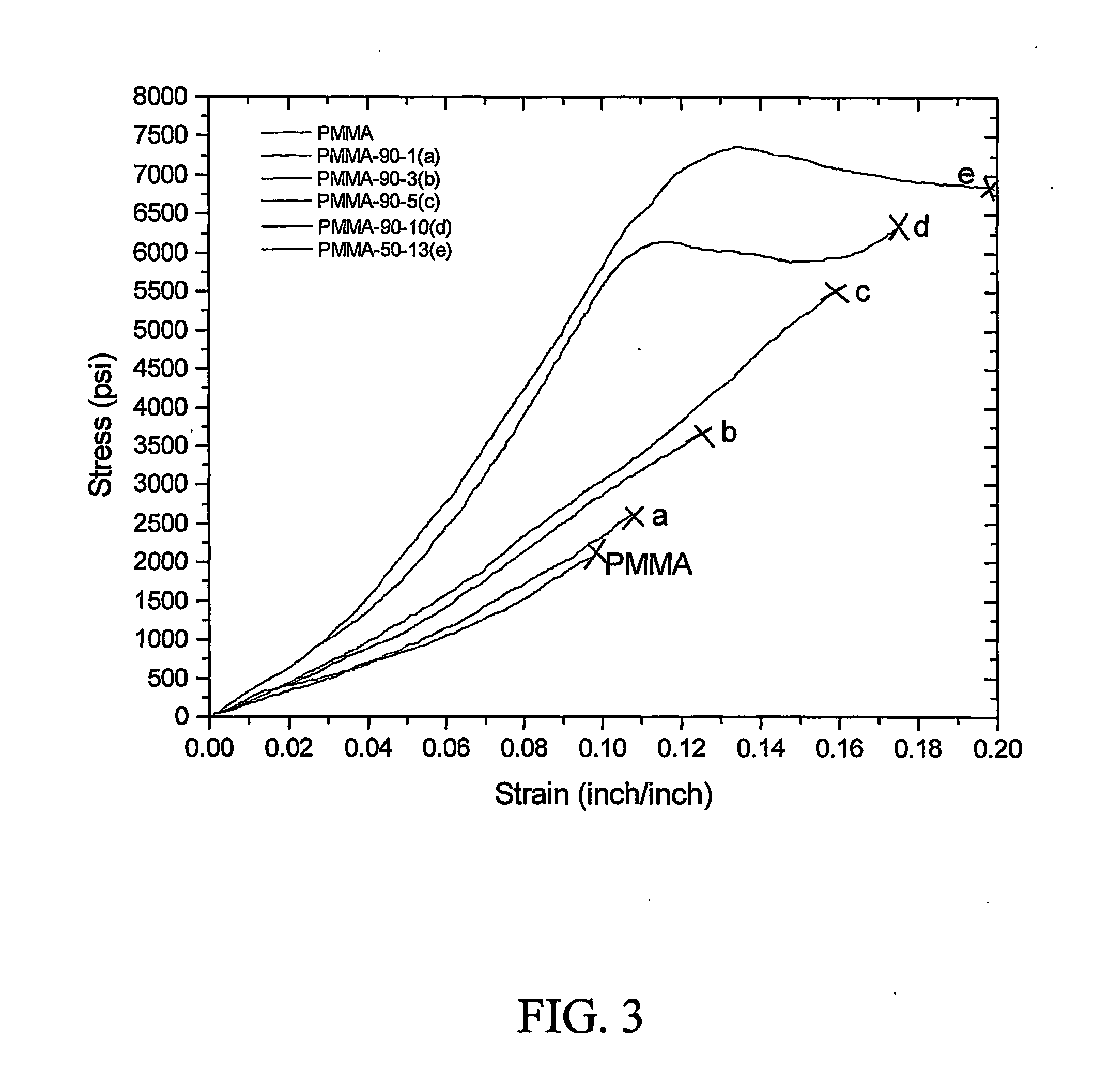Organic/inorganic nanocomposites obtained by extrusion
a technology of organic/inorganic nanocomposites and extrusion, which is applied in the direction of transportation and packaging, other chemical processes, chemistry apparatus and processes, etc., can solve the problems of weak materials, poor physical properties, and agglomeration of inorganic components, and achieves increased productivity and applicability of nanocomposites, high concentration, and strong interfacial interactions
- Summary
- Abstract
- Description
- Claims
- Application Information
AI Technical Summary
Benefits of technology
Problems solved by technology
Method used
Image
Examples
example 1
[0059] Surface Modification of Silica Additive for Production of PMMA / Silica Nanocomposites.
[0060] Silica modification was carried out in THF with APTMOS as the surface modifier and 0.1 N HCl solution as the hydrolysis reagent. FIG. 2 depicts the surface modification of silica. Nano-scale silica was obtained from DEGUSSA Corp. (Dusseldorf, Germany) and surface modifiers were purchased from GELEST, Inc. (Fullytown, Pa.).
[0061] The silica surface is covered with the surface modifier through chemical bonding, which should have similar functional groups pendant outside the silica surface. This kind of modification should offer good compatibility between modified silica and PMMA if they can be homogeneously dispersed into the PMMA matrix. Fumed silica was first dispersed in TBF, then 2 mole ratios of APTMOS and 0.1 N of HCl solution were added to the above solution according to the moles of silanol groups on the silica surface. The mixture was subjected to magnetic stirring at room tem...
example 2
[0062] Solution Blending of Surface Modified Silica with PMMA Solution to Produce Organic / Inorganic Concentrates.
[0063] The PMMA solution was formed from PMMA pellets dissolved in toluene. The surface modified silica and the PMMA solution were mixed together by mechanical stirring for 24 hours, and the resulting solution was cast into a film and dried for 6 days under atmospheric conditions. Final materials were dried for 1 day at 60° C. under vacuum before testing. Nanocomposites with 5%, 10%, and 15% (by weight) of OX80 type silica were prepared by the methods described in Examples 1 and 2. PMMA / silica concentrates were prepared identically as the nanocomposites, using all five silica types, ie., AEROSIL OX50, AEROSIL OX80, AEROSIL 90, AEROSIL 130, and AEROSIL 300, which have an average particle size of 40 nm, 30 nm, 20 nm, 16 nm, and 7 nm, respectively. However, the concentrates have 30% silica content (by weight) and were subsequently extruded, as described in Example 3. The re...
example 3
[0064] Co-Extrusion of PMMA Pellets with Organic / Inorganic Concentrates to Form PMMA / Silica Nanocomposites.
[0065] PMMA / silica nanocomposites were obtained by co-extruding PMMA pellets and concentrates formed by solution blending. CP-61 PMMA resin was obtained in the form of pellets (ICI ACRYLICS, Inc., Memphis, Tenn.). A ¾″ Table Top Independent Extruder was used to form the PMMA / silica nanocomposites. Concentrates and PMMA pellets were pre-dried under vacuum at 100° C. for one day to eliminate moisture and extra solvent in these materials. The temperatures of the four heating zones of the extruder were 210° C., 215° C., 220° C., and 220° C. respectively, and a 2″ ribbon die was used at the orifice of the extruder.
[0066] PMMA / silica concentrates and PMMA pellets were co-extruded and the final materials were subjected to property testing. The weight ratio of the concentrates and PMMA was determined by the silica content dispersed in the final material. The PMMA / silica nanocomposite...
PUM
| Property | Measurement | Unit |
|---|---|---|
| size | aaaaa | aaaaa |
| size | aaaaa | aaaaa |
| size | aaaaa | aaaaa |
Abstract
Description
Claims
Application Information
 Login to View More
Login to View More - R&D
- Intellectual Property
- Life Sciences
- Materials
- Tech Scout
- Unparalleled Data Quality
- Higher Quality Content
- 60% Fewer Hallucinations
Browse by: Latest US Patents, China's latest patents, Technical Efficacy Thesaurus, Application Domain, Technology Topic, Popular Technical Reports.
© 2025 PatSnap. All rights reserved.Legal|Privacy policy|Modern Slavery Act Transparency Statement|Sitemap|About US| Contact US: help@patsnap.com



